Charles Street runs from Greenwich Avenue to West Street just north of West 10th. The principal heir of Sir Peter Warren, who owned the land where Charles Street is found in the colonial era, was a fellow named Charles Christopher Amos, and those names were applied to streets when they were built through the area by 1800. Amos Street became a western extension of West 1oth Street in 1857. In early February I entered the Village, which had become Kadath in the Cold waste after a succession of days in the teens and several snowstorms, because the cabin fever was becoming too much. After my tearducts reacted to the cold inopportunely and my eyes were repeatedly annoyingly blurred, I scurried back indoors, but not before squeezing off some photos of the West Village in winter.

Most of the buildings on Charles Street went up between the 1850s and 1890s, with a couple of older and younger exceptions. #11 Charles Street for two years (1925-1927) was home to journalist/crime novelist James Cain, three of whose books became major motion pictures: The Postman Always Rings Twice (1934), Double Indemnity (1936) and Mildred Pierce (1941). Cain was born in Maryland and in his youth reported for the Baltimore American and Baltimore Sun, where he befriended his mentor, H.L. Mencken. During his two year in NYC he was an editorialist for the New York World and later The New Yorker; he moved to southern California in 1932, but other writers adapted his novels for film.
“I make no conscious effort to be tough, or hard-boiled, or grim, or any of the things I am usually called. I merely try to write as the character would write, and I never forget that the average man, from the fields, the streets, the bars, the offices and even the gutters of his country, has acquired a vividness of speech that goes beyond anything I could invent, and that if I stick to this heritage, this logos of the American countryside, I shall attain a maximum of effectiveness with very little effort.” Preface of Double Indemnity

#39 Charles Street, the building in the center behind the tree, was home to the “Little Flower,” Fiorello LaGuardia, from 1914 to 1921. He is rightly famed for his tenure as NYC Mayor from 1934-1945, but while living here, he became Deputy Attorney General of New York in 1915, and in 1916 was elected to the US House of Representatives and served there until December 31, 1919. During World War I LaGuardia joined the US Army and rose to the rank of major in command of a unit of bombers on the Italian-Austrian front. In 1919, LaGuardia ran as a Republican for the President of the NYC Board of Aldermen (the equivalent of today’s City Council President) and won. He returned to Congress in 1922 and served eleven years before his election as NYC mayor.

Though there are new versions of Bishop Crook lamps by the thousands in NYC these days, at the corner of Charles and West 4th is a bishop crook remnant — just the base is remaining from a former Type 6 BC (for Bishops Crook). Type 6’s are recognizable by their thinner bases, as they were generally deployed on narrower streets and sidewalks. This remnant used to list noticeably until restored to an upright position several years ago. There’s only one Type BC in working condition remaining — and that’s a restored lamp on Warren Street in Tribeca.

Until 1936, an unusual condition existed on Charles Street between West 4th and Bleecker Streets — the north side of the street, and only the north side of the street, was called Van Nest Place (after a former estate) and had its own separate house numbers. In 1936 the entire street, on both sides, became Charles Street. This kind of arrangement was once common but can’t be found in NYC anymore, although there is an unusual arrangement for Leroy Street in the Village, which turns in to Saint Lukes Place between 7th Avenue South and Hudson Street at a bend in the road between the two streets. Leroy Street resumes west of Hudson Street.
#53 Charles Street (formerly #2 Van Nest Place) is the Congregation Darech Amuno synagogue. As with many of the buildings in Manhattan that catch my eye, the Daytonian in Manhattan has been here before me:
… Established in 1838, the Dutch congregation had moved throughout the 19th Century from Greene Street, to 99 Sixth Avenue, to 7 Seventh Avenue, to 278 Bleecker Street, to a synagogue on West 4th Street, before purchasing the 1868 house on quiet Van Nest Place in 1912.
Rather than starting from scratch, architects Sommerfeld & Steckler altered the existing structure. The five-year renovation gutted the townhouse. What resulted was a three-story classically-inspired structure that hugged the property line. The nearly-flat fronted Roman design included a classical pediment and brick pilasters supporting stone cornices between each floor. The colorful stained glass of the dominating rose window, hefty fanlight over the entrance and six flanking windows highlighted the cream-colored brick trimmed in limestone.
The small synagogue is an unlikely concert venue, offering bluegrass and roots music.

Minnesotan author and playwright Sinclair Lewis (1885-1951) lived at #10 Van Nest Place, now #69 Charles Street, from 1910-1913, well in advance of his literary success with Main Street (1920), Babbitt (1922), Arrowsmith (1925), Elmer Gantry (1927), and Dodsworth (1929).Lewis turned down the Pulitzer Prize for Arrowsmith but accepted the Nobel Prize for Literature in 1930. In 1935 he published It Can’t Happen Here, a speculation about the election of a fascist to the US Presidency. Arrowsmith, Elmer Gantry and Dodsworth were made into acclaimed motion pictures.
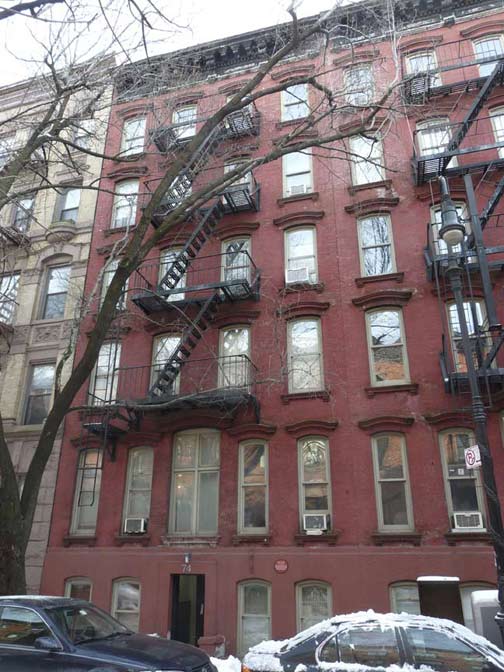

Folksinger Woody Guthrie (1912-1967) is perhaps famed more for living on Mermaid Avenue in Coney Island in the 1940s and 1950s in a building that has since been knocked down, but before arriving there, he briefly lived in this building (12/42 to 5/43) at #74 Charles Street, where a plaque has been installed by the Historic Landmarks Preservation Center. Guthrie, along with Pete Seeger, was a member of the Almanac Singers, who lived communally nearby at #130 West 10th Street, which they called The Almanac House; “Almanac” was inspired by the Old Farmer’s Almanac. The singers’ leftwing views earned them investigations by the FBI and they disbanded during World War II, but they re-formed, minus Guthrie but with other additions, as The Weavers in 1950, and enjoyed several top ten classics including their version of Leadbelly’s “Goodnight Irene.”

Hart Crane (1899-1932) is perhaps more associated with Brooklyn Heights, where he spent more time and inspired his most famous poetry works, “The Bridge,” but he lived here at #79 in 1920. Crane’s father was a candy manufacturer and held the patent for Life Savers before selling it for a song, only to see it go through the roof later on. Crane, troubled by alcoholism, committed suicide during a trip to Mexico in 1932.
Two doors down, poet and educator Delmore Schwartz (1913-1966), lived at #75 Charles from 1948-1951 while teaching at the New School. Schwartz was a major influence on the career of Lou Reed.

Dodging around the corner to #393 Bleecker Street, which doesn’t look like much to write home to Mother about on the exterior, but opens up to a wide courtyard on the interior. In the late 1920s, literary professor/author/poet Mark Van Doren agreed with like-minded neighbors to take down the back fences separating their properties that faced Perry and West 11th Streets and created a mutual yard shared by all. Van Doren was associated with Columbia University for over 50 years, between 1920 and 1972, mentoring Allan Ginsberg, Jack Kerouac and other poets who later became part of the Beat generation. At least one of the houses surrounding the so-called Bleecker Gardens was built before 1820.
Mark Van Doren’s son, Charles, competed successfully in 1959 on the Twenty One quiz show — before it was revealed that the show’s producers were slipping him the answers in response to his popularity. After the scandal broke, Van Doren moved with his family to Chicago, where he worked as an editor with the Encyclopedia Britannica.
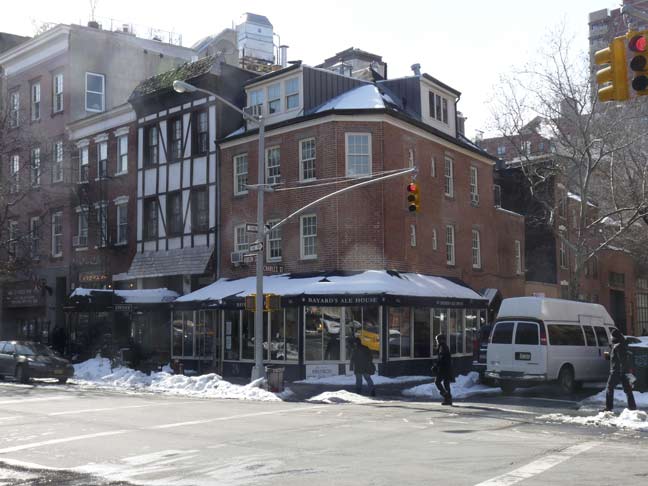
I’m showing this oddly-shaped (and probably very old) brick town house at Hudson and Charles Streets because a detailed map of Greenwich produced in 1961 by Lawrence Fahey that I acquired in the summer of 2013 has this as the location of the Lion’s Head Café Espresso. My understanding was that the Lion’s Head Inn was opened around the corner on Christopher Street from 1966 to 1996, so why would it be referenced in 1961? And why here?

120 Charles, between Hudson and Greenwich, was the home of journalist/poet/playwright Holly Beye (1922-2011) in 1949-1950, some of whose essays were collected in 120 Charles Street, The Village. The work had been lost for over fifty years, after Beye and her husband David Ruff moved to San Francisco, until it was rediscovered and published in 2006.

It appears as if 121 Charles , at the corner of Greenwich, has been here forever but it is actually a 1967 interloper. It is an 1809 farmhouse moved here by Sven and Ingrid Bernhart after it was discovered after a demolition on York Avenue and East 71st Street, and trucked downtown to this spot on March 6th of that year, along with some of the cobblestones adjacent to it: hence the building’s nickname “Cobble Court.” While uptown it had been the home of author Margaret Wise Brown (1910-1952; Goodnight Moon).
The building hasn’t been landmarked, as the Landmarks Preservation Commission sometimes doesn’t designate buildings that have been altered considerably from their original condition.


Unfortunately, in February 2014 both #131 (left) and #129 Charles Street were covered by netting and acaffolding as they underwent renovation. Hopefully the horse’s head and “H. THALMAN” on the outside of #129 will be retained — the building is a former stables. Though Herman Thalma(n)n’s stables only lasted a single year (1898-1899) the sign has been there since that time.
#131 is the older of the two, a Federal-style townhouse built in 1834.
There is a back house, #131-1/2, completely invisible from the street, accessible from the doorway in shadow at lower left. Famed photographer Diane Arbus lived in a converted stable here: her photographic portraits, mostly done in the 1950s and 1960s, captured an America that was decidedly different from the pleasant postwar period that major publications put forth for public consumption. Her husband in the 1950s, fashion photographer Allan Arbus (1918-2013), later turned to acting and played the kindly psychiatrist Dr. Freedman on the M*A*S*H TV version in the 1970s.


At 135 Charles Street near Washington is one of the more monumental police stations you’ll ever see. The grandeur was probably lost on the cops and crooks who went in and out of here every day. It was originally the 9th Precinct, designed by John DuFais and built in 1897, an era when most of NYC’s grandiose works went up. The precinct moved to a blander building on West 10th in 1972, becoming the 6th Precinct; as long ago as 1978 the Number 9 was converted to apartments, beating the old NYPD Headquarters on Centre Street in that regard. It is now known as Le Gendarme. It boasts what is probably one of the larger sculptures of the NYC Seal you will see on a building, though this one is a variant of the usual one (the Dutch sailor is holding an oar instead of a plummet).


Because of the snow, ice and construction across the street, I couldn’t get a good full-on view of #159 Charles, between Washington and West, so two side views will have to suffice. It was constructed in 1838 for merchant Henry Wyckoff. Overshadowed by the Richard Meier glassy apartment towers at Charles and West Streets, #159 and #161 are the only two 19th Century townhouses remaining on the block. Of the nine lots owned by Wyckoff on the block, only this one is here now. Ivy covers the outside wall in spring and summer.
Crazy from the cold but not yet willing to call it a day I stumbled up Washington Street and then at West 11th I encountered It:
Bear in mind I had yet to witness in person this monstrosity named Palazzo Chupi, executed atop a former stable building by artist/filmmaker Julian Schnabel. I had heard about it. It’s a pink Italianate tower rising about 100 feet above street level, dwarfing the other buildings on the block. Completed in 2008, original selling prices for some of its residential units (interiors here) rose as high as $32 million, which was later knocked down to “just” $12 million. (Honestly, where is all this scratch coming from?)

In the Palazzo’s shadow is a Greek Revival townhouse, #354 West 11th Street, built in 1842 for architectural ornament manufacturer William B. Fash on the site of a former soap factory. Everything else on this block has changed, even the building address and name of the street. This was originally 144 Hammond Street, but in the mid-1800s several Village street names were dropped and made western extensions of the numbered streets West 4th, 10th, 11th and 12th.
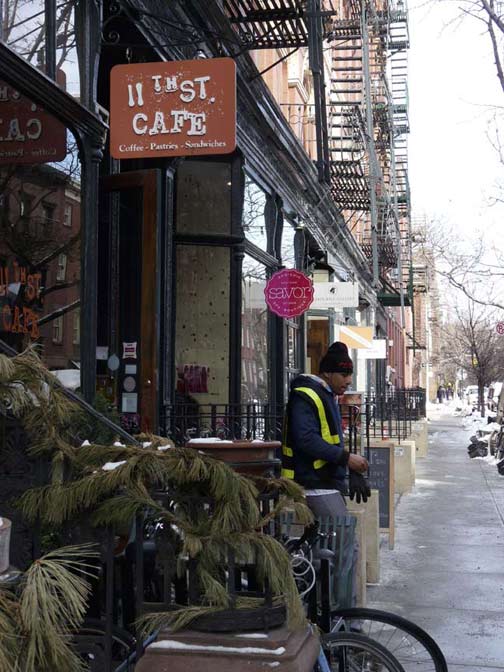

Shingle signs are the latest trend in advertising and scaffold signage. This one, for the 11th Street Cafe, is even handsomely embossed.

321 West 11th, hoisting a Chinese laundry on street level, looks like a slice of the old Village before it was all riched up. #321 was the home of author Carson McCullers (1917-1967) in 1940, when she wrote her best-seller, The Heart Is a Lonely Hunter, at just 22 years of age.
Thomas Wolfe lived at #263 West 11th between Bleecker and West 4th, from 1927-1828, finishing Look Homeward, Angel there; and Jack Kerouac worked on On the Road at his girlfriend’s apartment at #307, a building set back from the street, later owned by celebrity photographer Annie Liebowitz.

This building at Greenwich Street and West 11th is better seen in spring and summer, when it is covered in ivy.


Shifting over to Perry Street, the Spanish-style townhouse at #93, just off Bleecker, has a special place in the heart of H.P. Lovecraft fans. A courtyard leads to a back house, which is the supposed setting for one of the Ghostly Gentleman’s short stories written in 1925 during the Providence native’s “New York Exile.” In “He,” the narrator, roaming around the Village at night, meets a strange man professing to be a historian and antiquarian who has the ability to reveal Village scenes from centuries ago and also from the future. The two run into trouble when they disturb Native American spirits.
Perry Street: “Dog of the Ilk”

The Greenwich Village LPC Report is curiously silent on 48 Perry Street’s pair of iron dragons that guard the front entrance.


At #33… This distinguished brick building resembling a library has been, since 1926, a house with four high-ceilinged apax orients, but it was built as a stable in 1897. It is a very handsome transitional building, basically Romanesque Revival in style. It shows elements of design which herald the new classicism then coming into vogue, as may be seen in the brick quoins and in the deep roof cornice with horizontally placed console brackets. LPC Report linked above

#28 Perry Street, built as a 5-story brick apartment building in 1899, has a distinctive arched front entrance door with Corinthian-style pilasters that is likely the original.

Perry Street and Greenwich Avenue, where construction cranes signify more of the old Village going away.
Information in this page from Alfred Pommer and Eleanor Winter’s Exploring the Original West Village (though beware, they claim Arbus lived at 121-1/2 Charles, not 131-1/2 Charles.)
3/16/14




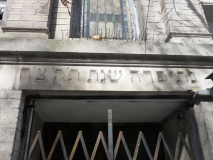

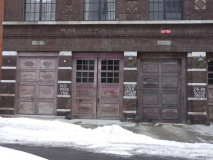

27 comments
I concur….where is all this scratch coming from??
I was delighted to see this. My paternal grandparents lived at 6 Charles St. raising 4 children. I remember visiting the apartment of this 5 story walk up (5 rooms 5th floor rear). In the late 60s a smaller building next door to the west was demolished just before the law was passed to preserve all the facades in the area. My grandmother, then widowed, had to move out about ’72 when she was pressured by the landlord to leave her rent controlled apartment. The building was then gutted and rebuilt leaving the facade in tact. Two of my uncles lived on Perry St. for a time after they were married. Thank you Kevin.
I lived on Bank st for a few years, not far from Charles. I’ve always enjoyed this part of the Village- very quiet, peaceful. thanks for the look at the ‘hood.
My last couple of times in the city I stayed at The Jane and have enjoyed getting to know the neighborhood. I was a Queens rat in my youth and this is a new experience for me.
King Juan Carlos of Spain would have been 14 years old when Margaret Wise Brown passed away. Are you sure about that? I guess it’s plausible, especially in the rarefied world of artists and royalty.
Must have been a different guy from Prince Juan Carlos…
Wow! so glad you braved the arctic weather to take these photos! Sinclair Lewis, Margaret Wise Brown, Diane Arbus, Jack Kerouac and so many others who have contributed so much to the world! It is always wonderful to wander around the Village, and even more wonderful to have the historic background provided. I read a biography of Margaret Wise Brown that has a photograph of Cobble Court and I am so thrilled to see it here. Thanks so much for this article!
You photo of 321 West 11th reminds me of paintings by Edward Hopper.
Ditto for the photo of Perry Street and Greenwich Avenue.
Keep up the great work!
Fine post as always, but what’s going on with P1070467, the building at Greenwich St and West 11th? It looks like a chunk of another photo was imposed at the bottom left. Speaking elsewhere of HP Lovecraft, beware that headless man!
Where do you think all the “scratch” is coming from?
It’s from rich Chinese slave-labor business-crooks, Russian billionaire-gangsters and Euro-trash sex-trade entrepreneurs; all laundering their dirty money through New York City real estate. Probably anticipating the coming implosion of their home countries.
A terrific look at the best part of t he city.
I can’t help wondering if the 11th Street Cafe’ was once an organic/macrobiotic place called East-West. Anyone? Great article, Kevin. So much talent centralized.
[…] Prince Charles: What do Fiorello LaGuardia, Woody Guthrie, Diane Arbus and Goodnight Moon have in common? [Forgotten NY] […]
[…] Prince Charles: What do Fiorello LaGuardia, Woody Guthrie, Diane Arbus and Goodnight Moon have in common? [Forgotten NY] […]
[…] Prince Charles: What do Fiorello LaGuardia, Woody Guthrie, Diane Arbus and Goodnight Moon have in common? [Forgotten NY] […]
I was walking around the West Village yesterday with a friend who had a recollection of the Lion’s Head Inn not being on Christopher Street by Sheridan Square but farther west. I was curious and found your article mentioning a Lion’s Head in 1961 in the West Village at Hudson and Charles. I then found this NYTimes article http://www.nytimes.com/1996/10/14/nyregion/closing-the-book-on-a-saloon-for-drinkers-with-writing-problems.html that stated: “The Lion’s Head, the history-soaked writers’ saloon where a generation of New York’s newshounds, novelists, poets and playwrights quenched their thirst for spirits and companionship with politicians, actors and anyone else who happened to stop by, closed yesterday morning. It was 38 years old and for the last 30 years had made its home at 59 Christopher Street in the West Village.” I don’t know it for a fact, but if the Lion’s Head was at a different location before spending its last thirty years on Christopher Street and if both the map you cited and my friend’s recollection place the Lion’s Head farther west, then I think that’s the answer: the Lion’s Head was at Hudson and Charles in 1961 before it moved to Christopher Street.
I lived at 11 Charles Street as a small child in 1948. I actually took my first steps in this building at 10 months old and have a photo of myself and my mom in front of the building. Every time I am in NYC I walk down this street and stop and wonder what it looks like inside. I only wish I still lived there! I have photos of my children in front of the building to hand down and hope to have my grandchildren photographed in the near future. One of my favorite restaurants is Sevilla at 62 Charles Street and eat there very trip. That was an Irish bar in the 40’s and although it is a Spanish restaurant, they make a great Irish coffee!! Thank you so much for this wonderful storybook of Charles Street. I just love it.
[…] Shot:- Michael is dragged into the police station house. Interior Shot: East Village 6th Precinct Police Station House: Desk Officer O’Brien (The desk officer looks at the two arresting officers and knows […]
48 Perry Street’s pair of iron dragons are not in the LPC’s report because these were probably more recent additions, these iron winged lions were actually originally freestanding newel posts, they had a rounded socket on top of their heads to accept the hand rail into them.
These two were obviously not originally where they are now on that ugly red concrete- the whole ground floor has been altered and appears to me it once was sandstone that spalled severely and was covered over with a stucco cement losing the window heads and the portico doorway which now sports a sort of mishapen blob of concrete loosely shaped to look like something it never was.
The steps would not have had those solid sides and ugly blocks of concrete newel posts. If the iron lions are ooriginal to the building the sides of the stairs would have been open and the lions WERE the newel posts.
These may not even be original to the building or even from the 1880s, they could have been purchased from one of the salvage stores or as reproductions. Urban Archaeology on Spring st had a pair of these in the late 70s and I had two pairs of them I removed from buildings by Forsyth st and the other from the South Bronx.
I sort of remember seeing a few years ago a web page for some iron foundry and restoration firm, and if I remember right, one of their completed jobs photos was of these lions at this building, I seem to remember the original wings were missing and they had fabricated replacements.
just googled and found it:
RESTORED CAST IRON GRIFFINS
Geenwich Village Historic District
http://www.architecturaliron.com/aic/NavIndex.htm
My grandparents lived in Greenwich Village from 1919 to 1922. We have a photo of my one year old aunt sitting in front of the double glass front doors with elaborate metal grill work. On the transom glass it says “Charles Court” in script. The doors have 553 and 555 on them individually, in script as well.
I would like to send you the photo to see if you can help me locate where this building is or was.
My sisters and brothers and myself grew up in the village my parents were the superintendents of 25 Charles Street.I lived there from the time I was four until the time I was twenty-six.We left the village and moved to Massachusetts my memories of my growing up on Charles Street are extremely happy.We swam in the pool on LeRoy Street on hot summer days and we attended P.S.3 on Bedford Street we watched various movie stars walking village streets some lived there some were sightseeing. I visited my old home at various times with my children and I must say that I miss the village with every passing day. I thoroughly enjoyed your history of Charles Street thank you for taking me down memory lane I will visit this site again and be sure to forwarded it to my two surviving brothers
5 Charles Street Rear House was the home of Spanish writer, Agustin Penon, who dedicated his career to write about Spanish poet Federico Garcia Lorca. https://www.universolorca.com/personaje/penon-agustin/
Directly across from 5 Charles street lived mid-century modern flemish artist Jan Yoors, His home still intact until today on the ground floor of 4 Charles street with all the looms still in place.
https://en.wikipedia.org/wiki/Jan_Yoors
Elizabeth O’reilly, I grew up at 25 Charles St, ground floor from 1943 to 1961. 7 children in the family and my Grandmother lived on the 2nd floor with 3 sons our Uncles. The superintendents at the time was the Stewart family, Leroy Street pool was our entertainment during our early years. It was a beautiful neighborhood, where the only problem was the roaches who lived there. We never locked our apartment, and everyone was friendly.
Does anyone happen to have a photo of Charles Street 1 from the Seventies? At that time, there was a framing shop/gallery at that address, run by Ms. Linda Johnson. I
would be delighted to see it.
I read where you stated that the Village Police Pct. was the 9th Pct. Growing up in the 40’s & 50’s I remember seeing Police cars with 6th Precinct on them. Even the movie Rear Window film in 1954 which starred Grace Kelly and James Stewart was filmed on 8th St in the Village. I believe James Stewart made reference to the 6th Precinct. I just read on the internet what you said was correct. Something ain’t right.